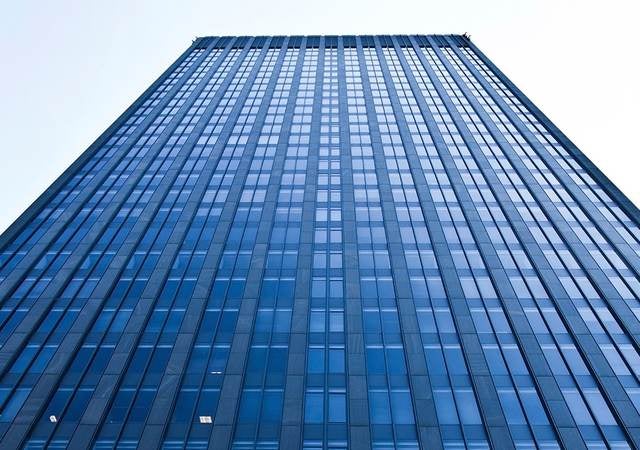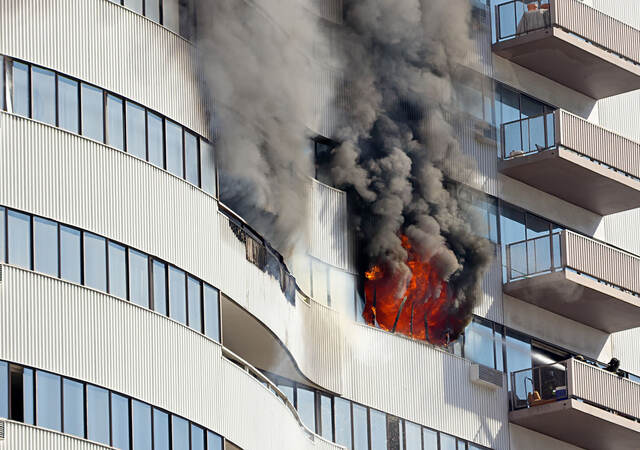December 4, 2020
Authored by: Jonathan Roberts and Luke C. Woods
Fire protection in the built environment is accomplished through two main approaches: active and passive fire protection. Active fire protection is generally something that causes a mechanism to take action and can require human intervention in some cases.Passive fire protection is installed as part of the built environment with a goal to restrict the passage of fire through proper fire containment. Throughout this article there are references to the International Building Code (IBC) and although passive fire protection related to exterior walls has been addressed in previous code editions, this article references the 2018 edition. While it is important to utilize a balanced fire protection approach by applying both active and passive fire protection measures, this article will focus on the passive fire protection methods, allowances and applications.
Passive fire protection, in the form of fire resistance rated construction, is an important concept within buildings, but it also applies to the exterior walls to stop the spread of fire across buildings adjacent to each other. Fire resistance ratings for exterior walls are one of the many things that must be determined during construction of a building. The building codes dictate that when exterior bearing wall assemblies are required to carry a fire resistance rating that they be tested and comply with UL 263, the Standard for Fire Tests of Building Construction and Materials.
When constructing a building, determining if an exterior wall needs to be fire resistance rated is an important initial step. The IBC provides the information needed to address the required level of fire resistance based on the type of construction as well as requirements for occupancy separations and the separation distances required between structures.
Table 602 of the IBC details the minimum separation distances required for each type of construction and occupancy type. The required ratings range from 0 to 3 hours, depending on the corresponding fire separation distances that range from less than 5 feet to more than 30 feet.
One example is an assembly occupancy type composed of type IIB building construction having nonbearing exterior walls. Per chapter 6, an exterior wall fire resistance rating would not be required if the separation is between 10 and 30 feet from an adjacent lot line or structure. If the distance between structures is greater than 30 feet, all types of construction and building occupancies are permitted to have a fire resistance rating of 0 for the exterior wall as long as a fire resistance rating is not required by other sections of the code.

Items that project out from the face of a building also need to be taken into consideration when measuring the minimum separation distance and corresponding fire resistance. Chapter 7 of the IBC – specifically section 705 – contains a large amount of information related to this. It covers not only exterior walls, but also addresses any projections, bay windows and overhangs that may extend from a building into the space between buildings. Proper separation needs to be maintained in accordance with Table 705.2. This table illustrates the minimum fire separation distance and the minimum distances applying to projections from the line used to determine fire separation distance.
Openings in exterior walls are also an item to consider when focusing on fire resistance rated exterior walls. Openings are allowed in these types of exterior walls depending on certain factors. The determining factors include the fire separation distance and whether the opening will be unprotected – meaning it does not have a fire resistance rating assigned to it – or the opening will be protected, which is one using fire rated glazing, a fire rated door or other approved means to achieve a fire resistance rating.
So, when it comes to openings in exterior fire resistance rated walls, there are several factors and many exceptions that can apply. When openings are allowed in these walls, there are limitations that apply to the size of allowable openings. These limitations are shown in the code as an aggregate percentage of the overall wall area. Table 705.8 illustrates the percentages of allowable opening area ranging from 0% to 100%. This table starts with buildings less than 3 feet apart as prohibited from having openings and ranges up to buildings that are over 30 feet apart having no limits on opening sizes. This percentage factors in if the openings are protected or unprotected, and takes into account if there are fire sprinklers present when determining the level of opening protection provided. The table in Chapter 7 and associated footnotes can help to determine the maximum area of allowable openings.
Many times, a door or a window must be installed in an exterior fire resistance rated wall and these may be required to be fire rated as well. Determining the fire resistance rating requirements of any allowable openings (or opening protectives) can be accomplished using section 716 of the IBC, which provides the fire resistance requirements for doors, windows, and sidelights or transoms in exterior walls.
Using the information in table 716.1(2) can help to determine what is specifically required for each condition. For example, a 1-hour fire resistance rated exterior wall assembly requires a door to have a 1-hour rating as well, but the windows, sidelights or transoms located within that wall would be permitted to have a ¾ hour fire resistance rating. The table also indicates the maximum allowable size of any vision panels installed within a door. In the same example, the size of any vision panels in the door would only be limited to the maximum tested in accordance with their certifications as long as it is fire resistance rated glazing tested in accordance with the requirements found in 716.1.2.3.
When determining the level of protection needed for exterior wall and whether or not a rated assembly may be required, the building code can provide a large amount of information related to the overall requirements. Once the determination has been made that a rated assembly or opening protective is required, an additional resource that can provide information related to specific assemblies or certified products is UL Product iQ™. Product iQ is free to use but does require a one-time registration.
You can use this online database to search with keywords or with a more refined and focused search utilizing the iQ Plus search tools. Using either of these avenues would allow you to easily and quickly locate detailed information and visual illustrations related to fire resistance as well as other pertinent material. It will also provide a link to the UL BXUV guide information. This guide is essentially covers all fire resistance rated assemblies. It provides information related to wall construction regarding any allowable alternate approaches that can be utilized as well as addressing additions to any designs. The guide contains a general section in which you can find many items including exterior walls. There is also a section that explains important concepts such as how the ratings for walls and partitions apply when either face of the assembly is exposed to the fire unless indicated otherwise in a specific design. This guide is an excellent source that provides a great deal of information that can help address many related questions.
For more information, please contact our UL Codes and Regulatory Services team or visit our UL Code Authorities web page where you will find several other resources that can help address the many issues that can arise in the built environment.
Passive Fire Protection: Fire Containment
This on-demand webinar is part of a six part digital event on Meeting the Challenges of the Future Built Environment series, experts discuss passive fire protection.
Building Confidence In Firestopping
This webinar series includes moderated discussions by UL experts covering various topics surrounding firestopping.
Get connected with our sales team
Thanks for your interest in our products and services. Let's collect some information so we can connect you with the right person.





